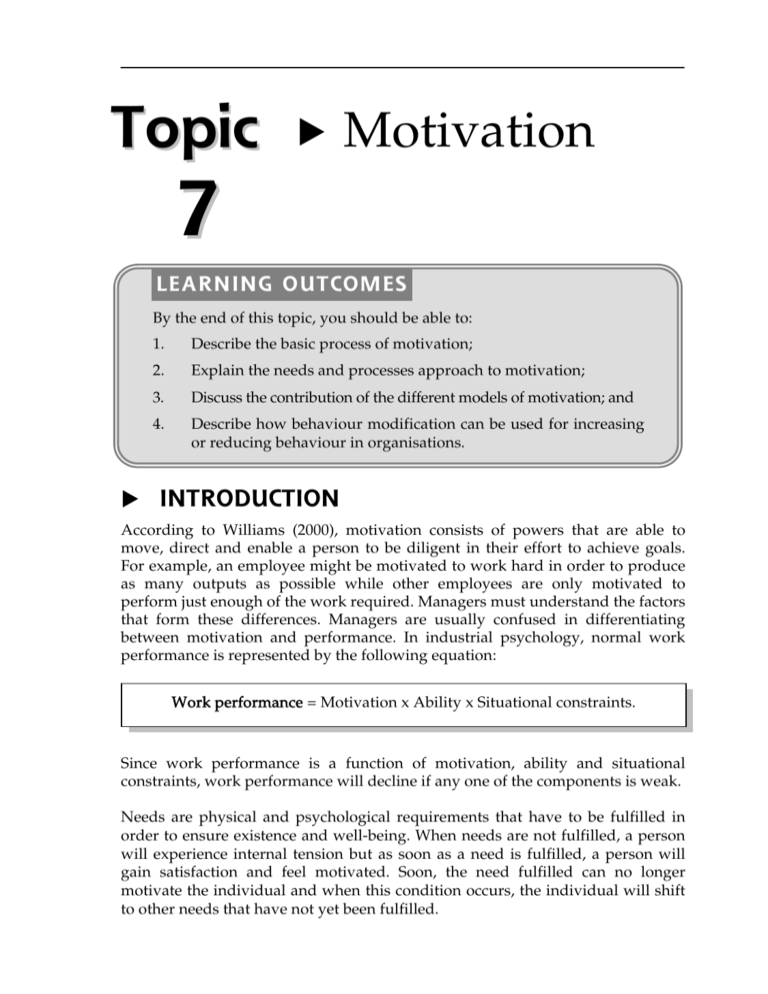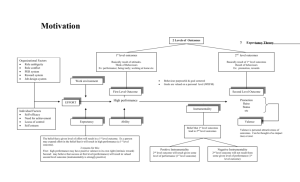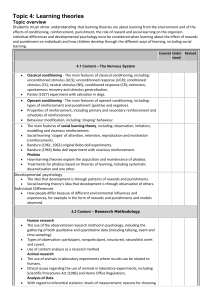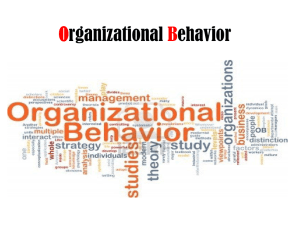Topic 7
advertisement

Topic Motivation 7 LEARNING OUTCOMES By the end of this topic, you should be able to: 1. Describe the basic process of motivation; 2. Explain the needs and processes approach to motivation; 3. Discuss the contribution of the different models of motivation; and 4. Describe how behaviour modification can be used for increasing or reducing behaviour in organisations. INTRODUCTION According to Williams (2000), motivation consists of powers that are able to move, direct and enable a person to be diligent in their effort to achieve goals. For example, an employee might be motivated to work hard in order to produce as many outputs as possible while other employees are only motivated to perform just enough of the work required. Managers must understand the factors that form these differences. Managers are usually confused in differentiating between motivation and performance. In industrial psychology, normal work performance is represented by the following equation: Work performance = Motivation x Ability x Situational constraints. Since work performance is a function of motivation, ability and situational constraints, work performance will decline if any one of the components is weak. Needs are physical and psychological requirements that have to be fulfilled in order to ensure existence and well-being. When needs are not fulfilled, a person will experience internal tension but as soon as a need is fulfilled, a person will gain satisfaction and feel motivated. Soon, the need fulfilled can no longer motivate the individual and when this condition occurs, the individual will shift to other needs that have not yet been fulfilled. 120 TOPIC 7 MOTIVATION CLASSICAL MODEL AND SCIENTIFIC MANAGEMENT 7.1 SELF-CHECK 7.1 After reading the segment above, do you still remember reading on the contribution by Frederick Taylor in the previous lesson? What were his contributions towards management? According to Rue et. al. (2000), in his classical motivation model, employees can be motivated by money. Frederick Taylor in his book, „The Principle of Scientific Management (1911),‰ suggested an approach for companies and employees in obtaining benefits based on his views on the workplace. He proposed that employees be paid a higher salary to encourage them to produce more outputs, which suits the opinion that employees can be motivated by money. Meanwhile for companies, they need to analyse the job and find the best ways to produce goods at lower costs, achieving a high level of profit and paying employees promptly in order to motivate them. The approach by Frederick Taylor is known as scientific management. His ideas spread widely among managers in the early twentieth century. For example, many factories in the United States of America hired experts to conduct studies on time and movement. The techniques of industrial engineering are used in every work section in determining how it can be performed effectively. 7.1.1 Approaches to Motivation According to Lewis et. al. (2001), motivation can be studied using several approaches. Models of motivation can be categorised into two types of models: need-based models and process-based models. Need-based models are motivation models that emphasise the specific needs of humans or internal factors that give power to direct or stop action. Need-based approaches explain motivation as a phenomenon that takes place internally. There are three important models in this approach: hierarchy of needs model, two-factor model and achievement of needs model. Process-based models are motivation models that focus on the understanding of thinking or the cognitive process that exist in the mind of an individual and actions that affect the behaviour of an individual. Douglas McGregor (1906 – 1964) introduced Theory X and Y about employees. Theory X comprised of negative attitudes, while Theory Y comprised of positive attitudes. TOPIC 7 MOTIVATION 121 Theory X states that people: (a) Dislike working and prefer to receive directives; (b) Must be forced to work; and (c) Prefer to avoid responsibilities and have low ambitions. Prioritise requirements for security rather than other requirements, that is Theory X is of the opinion that people define work only as a necessity to live and will avoid work whenever possible. Theory Y states that people: (a) Prefer to work; (b) Will achieve the objectives that are assigned/entrusted; (c) Will accept and seek responsibilities; and (d) Have the intellectual ability that can be used to achieve organisational objectives. According to Theory Y, people will be satisfied with their jobs if the working environment is suitable and they could implement their responsibilities well. Although most companies use/apply Theory Y in their management, Theory X is still being used in the management of some companies. EXERCISE 7.1 How do need-based models differ from process-based models? 7.2 NEED-BASED APPROACH 7.2.1 Maslow’s Hierarchy of Needs SELF-CHECK 7.2 Have you heard about MaslowÊs Hierarchy of Needs model? What do you know about this model of needs? According to Lewis et. al. (2001), MaslowÊs hierarchy of needs model is the most famous model for motivation. According to the hierarchy of needs, an individual has five basic needs – physiological, safety, social, esteem and self-actualisation. 122 TOPIC 7 MOTIVATION Figure 7.1 shows the five needs according to hierarchy and divided into upper level and lower level. Physiological and safety needs are lower-level needs that can be fulfilled externally while social needs, esteem needs and self-actualisation needs are upper-level needs that can be fulfilled internally. Refer to Table 7.1 for a description of each of these needs. Figure 7.1: MaslowÊs hierarchy of needs Source: Certo, S. C. (2000). Modern management (8th ed.). New Jersey: Prentice Hall Table 7.1: Description on MaslowÊs Hierarchy of Needs Needs Hierarchy Physiological Needs This need exists at the lowest level of the hierarchy. Examples of this need are the need for food, water, air and sleep. Organisations can help individuals to fulfil this need by preparing sufficient income to obtain food, shelter and a comfortable working environment. People will focus on fulfilling these needs before fulfilling the needs in the following level. Safety Needs This need is related closely to acquiring a safe physical and emotional environment. Examples of this need are employment network, health insurance and retirement plans used to fulfil the safety needs of employees. Social Needs After physiological and safety needs been fulfilled, social needs will become the main source of motivation to people. This need includes desire towards friendship, love and the feeling of belonging. An example of social need is when an employee establishes friendship in the workplace and feels a part of the organisation. TOPIC 7 MOTIVATION 123 Esteem Needs The needs at this level include the needs for status and recognition. This need can be fulfilled through success. Esteem needs are fulfilled when one is given recognition and respect by other people. For example, organisations can help in fulfilling this need through promotion or providing a spacious work station to the employee. People in need of recognition want themselves to be accepted based on their abilities and want to be known as being capable and efficient. Self-actualisation Needs This need is at the highest level of the hierarchy. This need means that people value high achievement based on their self-potential by using capability and interest to the maximum level in order to perform work in the environment. As an example, a challenging task can assist in satisfying a person towards the achievement of self-actualisation needs. According to Maslow, when a particular need has been fulfilled it will no longer motivate the behaviour of employees. For example, when an employee has gained confirmation in his work place, then a new retirement plan may become less important to him compared to the opportunity of having new friends and joining the informal group in the organisation. It is the same when the lowerlevel needs are not fulfilled, most people will pay attention to those particular needs. For example, an employee who is trying to fulfil the need for selfrecognition by holding an important position in a particular department suddenly finds out that the department and position he is going to hold may be eliminated, hence the employee may find that the chances of not being terminated in other organisations give more motivation to him compared to the offer of promotion in the previous organisation. MaslowÊs model identified that individuals have different needs which can be motivated by different matters or activities. Unfortunately, this model can only provide basic guidelines to managers. Many following studies conducted found that hierarchy level differs between individuals in different cultural environments. 7.2.2 Two-factor Model According to Rue et. al. (2000), the study done by Frederick Herzberg, Bernard Mausner and Barbara Snyderman produced an approach towards motivation that is accepted widely in the area of management. This approach is known by several names such as motivation and care approach, two-factor or motivation and hygiene approach. This model relates job satisfaction with productivity for a group of accountants and engineers. This study found that factors toward job 124 TOPIC 7 MOTIVATION satisfaction are separated from the factors that incline towards dissatisfaction of jobs. Figure 7.2 shows the two-factor model. Figure 7.2: Two-factor model Source: Lewis et. al. (2001). Management (a) Motivation Factors Motivation factors are factors related to the work performed. These factors are related to positive feelings and attitude towards the particular work. Motivation factors include the work itself, achievements, inner growth and responsibility. (b) Hygiene Factors These factors refer to the context of work or the environment where the work is being carried out. The factors include supervision, workplace conditions, individual relationship, salary, safety, and the companyÊs administration and policies. These factors are closely related to the negative feelings towards a particular job but nevertheless they do not contribute towards motivation. According to the researchers, these factors do not generate motivation but instead prevent motivation from occurring. For example, employees will feel dissatisfied if they believe that their work place is not safe; but if the condition of the workplace is improved, employees may not necessarily become satisfied. If employees are not given any recognition, feelings of dissatisfaction may not exist. At the same time although they may not feel satisfied but when recognition is given, employees will feel more satisfied. This theory suggests that managers should use two approaches in order to increase motivation. Firstly, they must ensure hygiene factors such as work environment are policies that are clearly stated and can be accepted by the employees. This practice will reduce dissatisfaction of employees. For TOPIC 7 MOTIVATION 125 second step, managers must use motivational factors such as recognition and additional responsibilities as tools to increase satisfaction and motivation. In conclusion, this approach shows that motivation comes from the individual himself. Attention towards hygiene factors will help individuals to reduce excessive dissatisfaction. Both factors of motivation and hygiene need to exist together to promote motivation. The result of this study found that this two-factor model is effective in a professional workplace environment but is less effective in a clerical or manufacturing environment. EXERCISE 7.2 Describe the hygiene factors and motivational factors in the two-factor model. 7.2.3 Acquired Needs Theory According to Rue et. al. (2000), this motivation model focuses on the three needs that are important or related to the working environment, namely, achievement, affiliation and power. This model was developed by David Mc Clelland. The use of the word „needs‰ in this model differs from the hierarchy of needs approach. In this model, needs are assumed as something that can be learnt while Maslow viewed needs as inherited. Need for achievement is the desire to perform much better and more efficiently than before. The level of achievement motivation in a person depends on factors such as childhood, personal experiences and education and the type of organisation joined. Need for power refers to the desire to control, influence or be responsible over other people. Need for affiliation relates to the desire to maintain close and personal relationships. This need can involve personal authority or institutional authority. Meanwhile, the need for social acceptance is the desire for creating relationships with other people. According to McClelland, most people have already achieved certain levels of these needs and that they vary from one individual to another. In this model, when the strength towards these needs has been developed, it will be able to 126 TOPIC 7 MOTIVATION motivate the behaviour of individual in situations that will allow them to fulfil highly demanding needs. 7.3 PROCESS-BASED APPROACHES Employee motivation is a complex matter. Managers need to have a complete perspective regarding methods that can be implemented to face the particular situation. They need to understand the reasons why people have different needs and goals, why individuals need change and how employees change in order to satisfy their needs through various methods. The need for understanding these aspects of motivation is crucial since organisations face various management issues that are caused by changes in the global environment. Several models that can be used to understand the complex motivation process are expectancy model, equity model, goal-setting model and behaviour reinforcement model. 7.3.1 Expectancy Theory According to Rue et. al. (2000), this model was developed by Victor H. Vroom. The expectancy theory was based on the idea that employee believes in the association between effort, performance and result are the consequence of the value and performance that they have fixed on the result. Expectancy plays the role of determining their level of motivation. This theory assumed that the motivation level of employees depends on three basic beliefs which are expectancy, valence and instrumentality. Figure 7.3 shows the association between expectancy, instrumentality and valence. Figure 7.3 Association between expectancy, instrumentality and valence Source: Jones, G. R., George, J. M., & Hill, C. W. L. (2000). Contemporary management (2nd ed.). Boston: Irwin-McGraw Hill TOPIC 7 MOTIVATION 127 (a) Valence – EmployeesÊ belief regarding the value of outcome or simply how far the particular reward or outcome is attractive or desired. (b) Expectancy – EmployeesÊ belief that their effort will incline towards the level of performance desired or the assumption of the association between effort and performance. (c) Instrumentality – EmployeesÊ belief that the achievement of the performance level desired will lead to the outcome desired or the assumption of the association between performance and rewards. This model suggests that in order to become a highly motivated person, the three factors or beliefs must also be high. If any one of the factors declines, the overall motivation will also decline. Managers are able to use this model to motivate employees through systematic gathering of information regarding what employees want out of their job by creating a clear and simple association between rewards and individual performance, and also granting power or authority for the employee to make decisions. The measures mentioned will increase the expectancy of employees that hard work and effort will bring about excellent performance. 7.3.2 Equity Theory According to Rue et. al. (2000), this theory was proposed by J. Stacey Adams. This motivation model was based on the idea that people want to be treated equally in their relationship with other people. Inequality exists when an employee regards that his inputs or contributions in the form of time, effort, education, experience, skill, knowledge and all the efforts given to the work together with the outcome or rewards given by the organisation in the form of salary, benefits, recognitions and others are less compared to the contribution towards work and rewards received by other people. Figure 7.4 illustrates the situation of comparison and its association with perception. EmployeeÊs Self Comparison to Other People Perception Reward Input = Reward Input Equality Reward Input < Reward Input Inequality Reward Input > Reward Input Inequality Figure 7.4: Comparative situations and its association with perception Source: Bateman, T. S., & Snell, S. A. (1999). Management: Building competitive advantage (4th ed.). Boston: Irwin-Mc-Graw Hill 128 TOPIC 7 MOTIVATION For example, a graduate who has just completed his studies received a job offer to work with a company with a starting salary of RM24,000 per annum, having the facility of a company car, and sharing an office room with another employee. If he finds out that there is a new employee reporting for duty given the same salary and remuneration he received, he will feel that the treatment given is equal. But if the opposite happens, that is, if the new employee reporting for duty is given a salary of RM30,000 per annum, a bigger company car and a specific office room for himself, the particular employee will feel that inequality has taken place. For an individual who experiences equal treatment, the ratio of comparison may not necessarily be the same relatively. Based on the previous example, the employee who initially feels that there is inequality when the new employee receives a better remuneration will be able to alter that feeling when he finds out that the new employee has higher work experience and qualifications than himself hence he deserves the bigger remuneration based on his contributions towards the company. This theory also states that the existence of inequality can result in pressure equivalent to the level of inequality felt by the employee. This pressure will motivate a person to achieve equality or reduce inequality. There are several actions that can be taken to reduce inequality such as reducing inputs or contribution if it is much higher compared to the input and outcome received by other people, increasing input if input is much lower compared to others, demanding compensation such as a pay rise or deciding to resign from the job. EXERCISE 7.3 Explain the main differences between the expectancy theory and the equity theory. 7.3.3 Goal-setting Model According to Williams (2000), the goal-setting model is a motivation model that acts by increasing the efficiency and effectiveness of individuals, groups, departments or organisation by emphasising specifically on the outcomes expected. Goal is the target, objective or decision that a person tries to achieve. This model states that people will be motivated up to a certain level when they are given a specific goal, which is challenging and obtain feedback regarding their development towards achieving the particular goal. The basic components for a goal-setting model are that goals must be specific, challenging and acceptable; have performance feedback; and gives at the correct time. As a motivation tool, goal-setting can help employees in three ways: as a TOPIC 7 MOTIVATION 129 guideline and propeller of behaviour to support the goals of the organisation; provide challenges and standards that can be used to make evaluations; and for stating something important and preparing the framework for planning. An important aspect of this model is the involvement of employees in goalsetting. When the employees themselves determine the goals they want to achieve, it will be easier for them to accept the goal and become more committed. If employees are not involved or participation is only minimal in setting the goals, they normally will not be that interested in achieving the goals. 7.3.4 Reinforcement Model According to Rue et. al. (2000), the growth of the motivation reinforcement model was pioneered by B. F. Skinner. There are two assumptions for this theory which are that the behaviour of humans is determined by the environment and is associated with related laws that can be expected and altered. The basic idea that forms the core of this theory is the assumption that the outcomes or consequences of a personÊs behaviour at present will affect his behaviour in the future. The behaviour that results in positive outcomes will be repeated while the behaviour that results in negative outcomes normally will not be repeated. The outcomes or consequences of the behaviour of an individual are referred to as reinforcements. Basically, there are four types of reinforcements – positive reinforcement, negative reinforcement or avoidance, punishment and elimination. Figure 7.5 illustrates how behaviour can affect outcomes. Figure 7.5: Consequences due to behavioural actions Source: Bateman, T. S., & Snell, S. A. (1999). Management: Building competitive advantage (4th ed.). Boston: Irwin-Mc-Graw Hill (a) Positive Reinforcement Positive reinforcement is the contribution of positive outcome or consequence based on the desired behaviour. For example, organisations that pay cash bonus to salespeople who exceed the sales quota will encourage them to work more diligently in the future. 130 TOPIC 7 MOTIVATION (b) Negative Reinforcement Negative reinforcement means giving an opportunity to a person in order to avoid negative outcome or consequence through the desired behaviour. Negative and positive reinforcements can both be used to increase the frequency of desired behaviour. For example, making tax payment before the month of May will prevent a person from being fined. (c) Elimination Elimination involves the absence of positive outcome or effect, or drawing back the positive outcome that used to give effect from the desired behaviour. (d) Punishment Punishment is the negative effect that is a result from the occurrence of undesired matters. As an example, an employee who is always late for work can be suspended or have his pay detained. Both forms of elimination reinforcement and punishment can be used to reduce the frequency of undesired behaviour. There are many studies conducted that show that rewards can increase the level of satisfaction and motivation compared to punishment. Figure 7.6 below illustrates a summary of the reinforcement theory that was discussed above. Figure 7.6: The summary of reinforcement theory Source: Rue, L. W., & Byars, L. L. (2000). Management: Skills and application (9th ed.). Boston: Irwin-McGraw-Hill TOPIC 7 MOTIVATION 131 EXERCISE 7.4 Essay Question As a manager, you have decided to reduce the behaviour of a particular employee. What are the types of reinforcements that are suitable to be used and why? TRUE (T) or FALSE (F) Statements 1. The scientific management approach assumes that money is the main inducer to motivation. 2. The experience of an employee is an example of outcome or result in the equity model. 3. In the two-factor model, hygiene factors need to exist for true motivation to take place but motivation factors do not need to exist for true motivation to happen. 4. Valence in expectancy model refers to employeesÊ belief regarding the value of outcomes or consequences. 5. The key to a successful positive reinforcement is that rewards must be the result of performance. Multiple Choice Questions 1. „This model assumes that people are motivated towards lower level needs that has not yet been fulfilled.‰ What model of motivation is referred to above? A. goals reinforcement B. C. hierarchy of needs D. two-factor 2. Which motivation model states that needs are assumed as being learnt rather than being inherited? A. Two factor theory B. Maslow hierarchy C. Achievement of needs model D. Expectancy model 132 TOPIC 7 MOTIVATION 3. Which is not a component of the expectancy model? A. Valence Instrumentality B. C. Forecasting D. Expectancy 4. What is the negative effect that is a result of undesired behaviour under the behaviour reinforcement model? A. Elimination Positive reinforcement B. C. Negative reinforcement D. Punishment 5. According to the view of the two-factor model researcher, what factor can prevent motivation from occurring but does not actually produce motivation? A. Hygiene factors Motivation factors B. C. Equity factors D. Expectancy factors Motivation Caselet 1. What do you understand by the term motivation? 2. Differentiate between intrinsic and extrinsic motivation? 3. Which do you think is more important? TOPIC 7 MOTIVATION 133 There are two main approaches for explaining the aspects of motivation. Need-based approaches explain about motivation that exists and takes place internally or explains about what truly motivates people. Meanwhile, process-based approaches explain the cognitive process that affects human behaviour. The three needs-based models discussed were the hierarchy of needs model, two-factor model and achievement of needs model. In the process-based approach, there are four main models discussed namely the expectancy model, equity model, goal-setting model and behaviour reinforcement model. Equity model MaslowÊs hierarchy of needs Expectancy Reinforcement model Goal-setting model Valence Instrumentality








